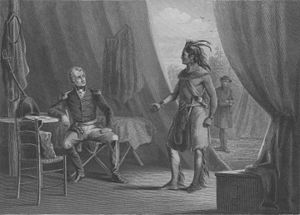Red Stick War
| Creek War | |||||||
|---|---|---|---|---|---|---|---|
| Part of American Indian Wars, War of 1812 | |||||||
 Depiction of William Weatherford surrendering to Andrew Jackson after the Battle of Horseshoe Bend. Jackson was so impressed with Weatherford's boldness that he let him go. |
|||||||
|
|||||||
| Belligerents | |||||||
|
Lower Creeks Cherokee Choctaw |
Red Stick Creek | ||||||
| Commanders and leaders | |||||||
|
|
William Weatherford Menawa Peter McQueen |
||||||
| Strength | |||||||
| 7,000 | 4,000 | ||||||
| Casualties and losses | |||||||
| ~584 killed, unknown wounded |
~1,597 killed, unknown wounded |
||||||
The Creek War (1813-1814), also known as the Red Stick War and the Creek Civil War, was a regional war between opposing Creek factions, European empires, and the United States, taking place largely in today's Alabama and along the Gulf Coast. The major conflicts of the war took place between state militias and the "Red Stick" Creeks.
The Creek War is part of the four-century long Indian Wars. It is also usually considered part of the War of 1812 because of its connection to Tecumseh's War in the Old Northwest, because it was concurrent with the American-British war and involved many of the same actors, and because the Red Sticks sought support from the British and later aided Admiral Cochrane's advance towards New Orleans.
The Creek War began as a conflict within the Creek Confederation, but United States armies quickly became involved. British traders and the Spanish government provided supplies to the Red Stick majority due to their shared interest in preventing the expansion of United States territory.
The war effectively ended with the Treaty of Fort Jackson (August 1814), where General Andrew Jackson insisted that the Creek confederacy cede more than 21 million acres of land from what became southern Georgia and central Alabama. These lands were taken from allied Creek as well as Red Sticks.
The Red Stick chiefs' and warriors' militancy was a response to the United States' cultural and territorial encroachment. The conflict's designation as the Creek Civil War comes from divisions along cultural, political, economic, and geographic boundaries. At the time of the Creek War, the Upper Creek controlled the Coosa, Tallapoosa, and Alabama Rivers that led to Mobile, while the Lower Creek controlled the Chattahoochee River, flowing into Apalachicola Bay. The Lower Creek were closer trading partners with the United States, and had adopted more of the cultural practices of their neighbors than the Upper Creek.
The Provinces of East and West Florida were governed by the Spanish, and British firms like Panton, Leslie, and Co. provided most of the trade goods into Creek country. Pensacola and Mobile in Spanish Florida controlled the outlets of the US Mississippi Territory's (established 1798) rivers.
...
Wikipedia
